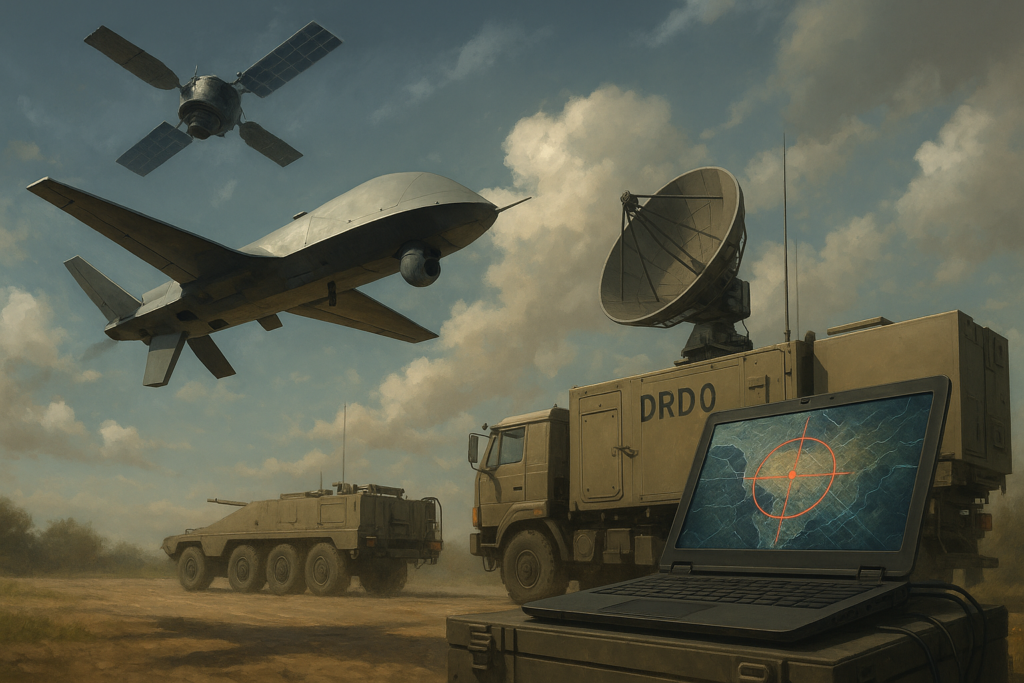In a development that has drawn sharp interest from global defense analysts, India has unveiled a cutting-edge autonomous warfare system known as AkashTeer—a layered, AI-powered battlefield cloud that integrates live satellite surveillance, indigenous GPS-guided targeting, and autonomous stealth drones.
Jointly developed by the Defence Research and Development Organisation (DRDO), Bharat Electronics Limited (BEL), and the Indian Space Research Organisation (ISRO), the system represents one of the most ambitious military integrations ever undertaken by a non-NATO country.
The revelation of AkashTeer has prompted quiet recalibrations across global defense corridors—from Washington to Beijing—owing to its entirely indigenous tech stack and autonomous decision-making capabilities in live combat scenarios.
What AkashTeer Actually Is: A System, Not a Weapon
Unlike traditional defense platforms centered around singular aircraft, radars, or missiles, AkashTeer is designed as a “system-of-systems.” It fuses:
- ISRO’s real-time Earth observation satellite feeds
- India’s NAVIC satellite navigation network
- Autonomous, AI-powered drone swarms
- BEL-built edge computing processors and field-deployable mobile control centers
The entire combat chain—from threat detection to target neutralization—is conducted with minimal to zero human intervention once operational.
“This is the future of battlefield autonomy—agile, decentralized, and entirely sovereign,” a senior DRDO official said on condition of anonymity.
Why This System Has Stirred International Attention
Real-Time Combat Intelligence from Indian Satellites
AkashTeer relies on live imagery from India’s Cartosat and RISAT satellites. This gives India an edge over countries still reliant on delayed or third-party data—especially in sensitive conflict zones. For the first time, New Delhi has eliminated dependence on foreign reconnaissance satellites.
Navigation Sovereignty Through NAVIC
India’s NAVIC GPS system offers superior accuracy in the Indian subcontinent compared to U.S. GPS or China’s BeiDou. In dense terrains and border regions where spoofing and jamming are routine, this localization offers India a critical tactical advantage.
Stealth Drones with Autonomous Capabilities
Each drone in the AkashTeer system weighs between 5 and 10 kilograms and can deliver payloads or carry out reconnaissance missions. The drones feature radar-absorbing materials, adaptive navigation, and AI-directed mission flexibility—a leap from operator-controlled drones like Turkey’s Bayraktar TB2 or U.S. MQ-1 Predators.
The AI Advantage: Zero-Latency Combat Response
AkashTeer’s defining feature is its ability to process satellite data, radar input, terrain maps, and weather conditions in real-time via edge AI processing. This allows the system to reroute drones, reassign targets, or abort missions in seconds, bypassing human command delay entirely.
Global Reactions: Measured, But Not Unmoved
United States: Defense planners at the Pentagon are said to be revisiting their assessments of India’s indigenous capabilities. Sources suggest that AkashTeer’s stealth drones simulated successful penetration into radar-shielded zones similar to those guarded by U.S. and NATO systems.
China: The unveiling has reportedly prompted urgent internal reviews in Beijing. Military analysts privately acknowledged that the system’s fusion of AI and satellite infrastructure “caught them off guard.”
Turkey: With its drone program considered one of the most advanced outside of NATO, Ankara was surprised by AkashTeer’s agility and autonomy. Experts compared the Indian system favorably for its swarm intelligence and deployment flexibility.
Pakistan: AkashTeer’s real-time capabilities were reportedly tested in simulated incursions near high-value installations. Reports suggest that no radar signature was detected, raising concerns in Islamabad over the effectiveness of its surveillance systems and U.S.-supplied defense equipment.
What Sets AkashTeer Apart?
- Zero Foreign Dependency: All components—hardware, software, navigation, and data—are built and managed within India.
- AI and Swarm Coordination: The system utilizes artificial intelligence to coordinate entire fleets of drones autonomously.
- Plug-and-Deploy: Compact mobile control centers allow AkashTeer to be deployed from remote locations and even moving vehicles.
- Rapid Response: With deployment timelines under two minutes, AkashTeer minimizes detection and maximizes precision.
A Strategic Shift, Not Just a Tactical Upgrade
AkashTeer’s significance lies not only in its technology but in its strategic signaling. For decades, India has relied on foreign suppliers and alliances for advanced military hardware. Now, with AkashTeer, it sends a clear message: India is prepared to lead, not follow, in next-gen defense paradigms.
Military analysts believe AkashTeer marks the beginning of a new doctrine—one that replaces manned oversight with autonomous command structures, drawing India closer to the AI warfare frontiers currently dominated by the United States, China, and Israel.
The Bigger Picture: Beyond the Subcontinent
For India, AkashTeer is more than a battlefield tool—it is a declaration of sovereignty in the most sensitive domain of national security. By eliminating dependencies on GPS, foreign processors, or satellite relays, India has asserted a form of military independence few countries have achieved.
“With AkashTeer, India hasn’t just matched global capability—it has introduced a new model of what decentralized, AI-first warfare might look like,” said Col. (Retd.) Anil Deshmukh, a defense strategist and author of The Coming War of Algorithms.


